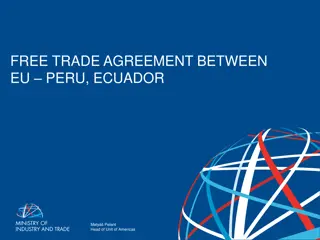Understanding the Impacts of Taxes, Subsidies, and Tariffs on Small Country Trade
In the realm of trade theory, a small country is one where local events don't influence global free trade prices. Tariffs, as taxes on imports, impact prices, consumption, and production by disrupting the equilibrium in a way that affects consumer and producer surpluses. These effects on prices and quantities, as well as welfare under free trade conditions, are essential to comprehend in international trade scenarios.
Download Presentation

Please find below an Image/Link to download the presentation.
The content on the website is provided AS IS for your information and personal use only. It may not be sold, licensed, or shared on other websites without obtaining consent from the author. Download presentation by click this link. If you encounter any issues during the download, it is possible that the publisher has removed the file from their server.
E N D
Presentation Transcript
Taxes, Subsidies, and Tariffs: Small Country Udayan Roy http://myweb.liu.edu/~uroy/eco41
What is a small country? In trade theory, a country is said to be small if events in that country can have no effect on worldwide free trade prices
What is a Tariff? A tariff is a tax on imported goods
The Effects of a Tariff A tariff is a tax on imported goods Tariffs raise the price of imported goods above the world price by the amount of the tariff. This Reduces consumption, Increases production, and thereby Reduces the amount imported
Effects of a Tariff on Prices and Quantities Price of Steel Domestic supply Equilibrium without trade Price domestic buyers pay -- and domestic producers receive -- after Tariff Tariff Price before tariff World free-trade price Imports with tariff Domestic demand QS QD QS QD Quantity of Steel 0 Imports under free trade
Welfare under free trade Price of Steel Consumer surplus before tariff Domestic supply Producer surplus before tariff Equilibrium without trade Price before tariff World free-trade price Domestic demand QS QD Quantity of Steel 0 Imports under free trade
Consumer Surplus after Tariff Price of Steel Consumer surplus after tariff Domestic supply A Equilibrium without trade B Price domestic buyers pay -- and domestic producers receive -- after Tariff Price before tariff Tariff World free-trade price Imports with tariff Domestic demand QS QD QS QD Quantity of Steel 0 Imports under free trade
Producer Surplus after Tariff Price of Steel Domestic supply Producer surplus after tariff Equilibrium without trade Price domestic buyers pay -- and domestic producers receive -- after Tariff Price before tariff Tariff C World free-trade price G Imports after tariff Domestic demand QS QD QS QD Quantity of Steel 0 Imports under free trade
Governments Revenue from Tariff Price of Steel Domestic supply Tariff Revenue Price domestic buyers pay -- and domestic producers receive -- after Tariff Tariff E Price before tariff World free-trade price Imports after tariff Domestic demand QS QD QS QD Quantity of Steel 0 Imports under free trade
Effects of Tariff on Social Welfare Price of Steel Domestic supply A Deadweight Loss B Price domestic buyers pay -- and domestic producers receive -- after Tariff Tariff C D E F Price before tariff World free-trade price G Imports after tariff Domestic demand QS QD QS QD Quantity of Steel 0 Imports without tariff
Effects of Tariff on Social Welfare Price of Steel Domestic supply A Deadweight Loss B Price domestic buyers pay -- and domestic producers receive -- after Tariff Tariff C D E F Price before tariff World free-trade price G Imports after tariff Domestic demand QS QD QS QD Quantity of Steel 0 Imports without tariff
Welfare Effects of a Tariff Consumers of the imported good are worse off (compared to free trade) Producers of the imported good are better off The government gains some revenue Total surplus decreases because the loss to consumers is larger than the gains to the producers and to the government The decrease in total surplus is called the deadweightloss of the tariff.
Tariffs are third best The tariff can be thought of as the combination of a production subsidy and a consumption tax The only rationale for a tariff is that it helps producers But even that goal can be better achieved by using the production subsidy alone That way, the damaging effects of the consumption tax can be avoided
Consumption Tax Consider a country that has free international trade What are the effects of a consumption tax on an imported good? Buyers must pay more (than the worldwide free-trade price, by the amount of the tax) So, they will buy less Domestic producers are unaffected So, imports decrease
Consumption Tax Price of Steel Domestic supply Equilibrium without trade Purchase price after tax Consumption Tax Purchase price before tax World free-trade price Imports after tax Domestic demand S QS QD QD Quantity of Steel 0 = Q Imports under free trade
Consumption Tax Price of Steel Free Trade Consumption Tax Consumers Surplus ABCDEF AB Domestic supply Producers Surplus G G Government CDE (Tax revenue) Total Surplus ABCDEFG ABCDEG Deadweight loss of the consumption tax A Equilibrium without trade B Purchase price after tax Consumption Tax C D E F Purchase price before tax World free-trade price G Imports after tax Domestic demand S QS QD QD Quantity of Steel 0 = Q Imports under free trade
Consumption Tax Free Trade Consumption Tax Consumers Surplus Producers Surplus Government Total Surplus The deadweight loss of the consumption tax is F, less than D + F, the deadweight loss of the tariff. ABCDEF AB G G CDE ABCDEFG ABCDEG
Consumption Tax When a small country imposes a consumption tax on the imported good Production is unchanged, and Consumption decreases. Therefore, The amount imported decreases. Consumers lose Producers are unaffected The government gains some tax revenue The country as a whole is worse off
Production Subsidy A subsidy is the opposite of a tax The government pays people (instead of taking from people) What happens when the government gives domestic producers of an imported good a subsidy for every unit produced? Domestic production increases Consumers are unaffected So, imports decrease
Production Subsidy Price of Steel Domestic supply Price sellers get after subsidy Production Subsidy Price sellers get before subsidy World free-trade Price price buyers pay, with or without the subsidy Imports after subsidy Domestic demand QD QS QD QS = Quantity of Steel 0 Imports under free trade
Production Subsidy Price of Steel Domestic supply A Deadweight Loss B Price Production Subsidy For sellers C D E F Price World price G For buyers Imports with subsidy Domestic demand QD QS QD QS = Quantity of Steel 0 Imports under free trade
Free Trade Production Subsidy Consumers Surplus ABCDEF ABCDEF Production Subsidy Producers Surplus G CG Government -CD (Cost of Subsidy) Price of Steel Total Surplus ABCDEFG ABCEFG Domestic supply A Deadweight Loss B Price Production Subsidy For sellers C D E F Price World price G For buyers Imports with subsidy Domestic demand QD QS QD QS = Quantity of Steel 0 Imports under free trade
Production Subsidy Free Trade Production Subsidy ABCDEF Consumers Surplus Producers Surplus Government ABCDEF G CG -CD Total Surplus ABCDEFG ABCEFG
Production Subsidy When a small country gives a subsidy to domestic producers of an imported good Consumers are unaffected Producers gain (C), same as under the tariff Taxpayers lose; they pay for the subsidy (CD) Overall, the country is worse off (D). Recall that under the tariff, the country suffered even more (DF) Tariffs are third best
Q: What if a tariff is replaced by a production subsidy and a consumption tax, both equal in size to the tariff? A: The outcome is identical to the outcome under the tariff. Price of Steel Domestic supply Equilibrium without trade Price Tariff with tariff Price World free-trade price without tariff Imports with tariff Domestic demand QS QD QS QD Quantity of Steel 0 Imports without tariff
Tariffs are third best The tariff can be thought of as the combination of a production subsidy and a consumption tax The only rationale for a tariff is that it helps producers But even that goal can be better achieved by using only a production subsidy That way, the bad effects of the consumption tax can be avoided
Tariffs are third best We can also establish the superiority of the production subsidy over the tariff by a head-to-head comparison
Tariff Production Subsidy Q: What if a tariff is replaced by a production subsidy equal in size to the tariff? Consumers Surplus AB ABCDEF Producers Surplus CG CG Government E -CD Price of Steel Total Surplus ABCEG ABCEFG A: Producers would not complain. Consumerswould be delighted. Taxpayers would complain. The country as a whole would be better off. Domestic supply A B Price Production Subsidy For sellers C D E F Price World price G For buyers Imports with subsidy Domestic demand QD QS QD QS = Quantity of Steel 0 Imports under free trade
In its welfare effects, not all that different from the tariff BONUS MATERIAL: THE IMPORT QUOTA
The Effects of an Import Quota An import quota is a limit imposed by the domestic government on the quantity of a good that can be produced abroad and sold domestically.
The Effects of an Import Quota Price of Steel Domestic supply Equilibrium without trade Domestic supply + Import supply Quota Isolandian price with quota Equilibrium with quota Price without quota World price World price = Imports with quota Domestic demand QS QS QD QD Quantity of Steel 0 Imports without quota
The Effects of an Import Quota Because the quota raises the domestic price above the world price, domestic buyers of the good are worse off, and domestic sellers of the good are better off. Import license holders are better off they make a profit from buying at the world price and selling at the higher domestic price.
The Effects of an Import Quota Price of Steel Domestic supply Equilibrium without trade Domestic supply + Import supply Quota A Isolandian price with quota B Equilibrium with quota E' C D F E" Price without quota World price World price = G Imports with quota Domestic demand QS QS QD QD Quantity of Steel 0 Imports without quota
The Effects of an Import Quota With a quota, total surplus in the market decreases by an amount referred to as a deadweight loss. The quota can potentially cause an even larger deadweight loss, if a political mechanism such as lobbying is employed to allocate the import licenses.
Tariffs v. Quotas If government sells import licenses for full value, the revenue would equal that from an equivalent tariff and tariffs and quotas would have identical results. Otherwise, quotas are worse than tariffs
The Lessons for Trade Policy Both tariffs and import quotas . . . raise domestic prices. reduce the welfare of domestic consumers. increase the welfare of domestic producers. cause deadweight losses.























